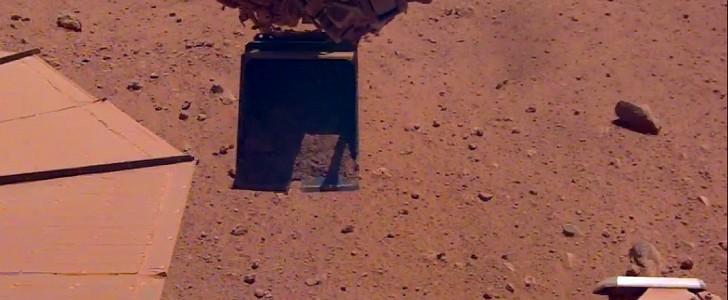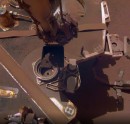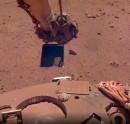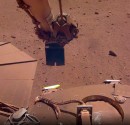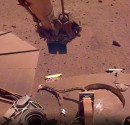Dust storms are a common occurence on Mars and they constantly threaten the spacecraft lives by covering their solar panels. Back on Earth, NASA's InSight team has come up with an ingenious way to boost the lander's energy levels.
The spacecraft used its robotic arm to pour sand near one of its solar panels, allowing the wind to blow away some of the accumulated dust. This helped InSight gain 30 watt-hours of energy per Martian day.
For nearly a year, NASA has been trying to find ways to clean the dust from the lander's solar panels. The team has previously attempted to shake the dust off by pulsing the panels' deployment motors, but it was of no use.
This time, the researchers tried to counterattack sand with sand. The way this method would have worked was by striking dust on the panels with sand grains that would bounce off and be blown away by the wind. Smaller dust particles would've been carried away by the larger grains.
The plan was set in motion on May 22nd, around noon, when it was the windiest time of the day. First, the team used InSight's robotic arm to scoop some sand and pour it next to its solar panels. Then, the winds, which were blowing northwest at a maximum speed of 14 mph (23 kph), kicked off some of the dust from the lander. As a result, the spacecraft got an energy boost.
This technique will be attempted one more time on June 5th to clear a bit more dust from the panels. This energy boost should be enough to delay InSight instruments' shut down by a few weeks, giving scientists more time to collect scientific data.
Less sunlight will reach the spacecraft's dust-covered solar panels as Mars approaches aphelion, its furthest point from the Sun. Therefore, InSight's team has planned the lander's two-year mission extension to function without science instruments for the next few months. Although they will be turned off, the spacecraft will still save power for its heaters, computer, and other crucial components.
According to NASA, as the Red Planet will orbit closer to the Sun, InSight's solar panels should be able to store more energy, allowing the team to restart the science instruments by August.
For nearly a year, NASA has been trying to find ways to clean the dust from the lander's solar panels. The team has previously attempted to shake the dust off by pulsing the panels' deployment motors, but it was of no use.
This time, the researchers tried to counterattack sand with sand. The way this method would have worked was by striking dust on the panels with sand grains that would bounce off and be blown away by the wind. Smaller dust particles would've been carried away by the larger grains.
The plan was set in motion on May 22nd, around noon, when it was the windiest time of the day. First, the team used InSight's robotic arm to scoop some sand and pour it next to its solar panels. Then, the winds, which were blowing northwest at a maximum speed of 14 mph (23 kph), kicked off some of the dust from the lander. As a result, the spacecraft got an energy boost.
This technique will be attempted one more time on June 5th to clear a bit more dust from the panels. This energy boost should be enough to delay InSight instruments' shut down by a few weeks, giving scientists more time to collect scientific data.
Less sunlight will reach the spacecraft's dust-covered solar panels as Mars approaches aphelion, its furthest point from the Sun. Therefore, InSight's team has planned the lander's two-year mission extension to function without science instruments for the next few months. Although they will be turned off, the spacecraft will still save power for its heaters, computer, and other crucial components.
According to NASA, as the Red Planet will orbit closer to the Sun, InSight's solar panels should be able to store more energy, allowing the team to restart the science instruments by August.
